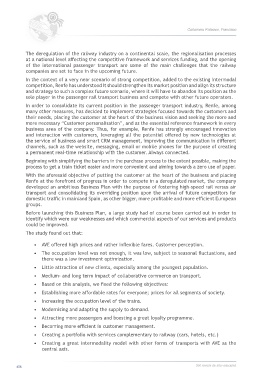Page 458 - 360.revista de Alta Velocidad - Nº 6
P. 458
Cañamero Palacios, Francisco
The deregulation of the railway industry on a continental scale, the regionalisation processes
at a national level affecting the competitive framework and services funding, and the opening
of the international passenger transport are some of the main challenges that the railway
companies are set to face in the upcoming future.
In the context of a very near scenario of strong competition, added to the existing intermodal
competition, Renfe has understood it should strengthen its market position and align its structure
and strategy to such a complex future scenario, where it will have to abandon its position as the
sole player in the passenger rail transport business and compete with other future operators.
In order to consolidate its current position in the passenger transport industry, Renfe, among
many other measures, has decided to implement strategies focused towards the customers and
their needs, placing the customer at the heart of the business vision and seeking the more and
more necessary “Customer personalisation”, and as the essential reference framework in every
business area of the company. Thus, for example, Renfe has strongly encouraged innovation
and interaction with customers, leveraging all the potential offered by new technologies at
the service of business and smart CRM management, improving the communication in different
channels, such as the website, messaging, email or mobile phones for the purpose of creating
a permanent real-time relationship with the customer. Always connected.
Beginning with simplifying the barriers in the purchase process to the extent possible, making the
process to get a train ticket easier and more convenient and aiming towards a zero use of paper.
With the aforesaid objective of putting the customer at the heart of the business and placing
Renfe at the forefront of progress in order to compete in a deregulated market, the company
developed an ambitious Business Plan with the purpose of fostering high-speed rail versus air
transport and consolidating its overriding position upon the arrival of future competitors for
domestic traffic in mainland Spain, as other bigger, more profitable and more efficient European
groups.
Before launching this Business Plan, a large study had of course been carried out in order to
identify which were our weaknesses and which commercial aspects of our services and products
could be improved.
The study found out that:
• AVE offered high prices and rather inflexible fares. Customer perception.
• The occupation level was not enough, it was low, subject to seasonal fluctuations, and
there was a low investment optimization.
• Little attraction of new clients, especially among the youngest population.
• Medium- and long term impact of collaborative commerce on transport.
• Based on this analysis, we fixed the following objectives:
• Establishing more affordable rates for everyone; prices for all segments of society.
• Increasing the occupation level of the trains.
• Modernising and adapting the supply to demand.
• Attracting more passengers and boosting a great loyalty programme.
• Becoming more efficient in customer management.
• Creating a portfolio with services complementary to railway (cars, hotels, etc.)
• Creating a great intermodality model with other forms of transports with AVE as the
central axis.
456 360.revista de alta velocidad

